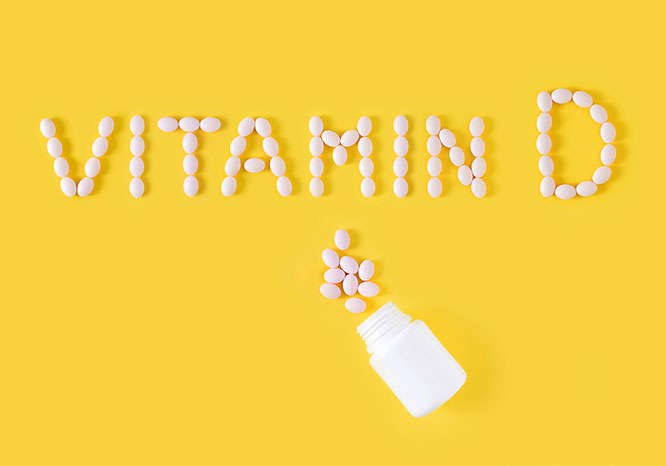Vitamin D has several crucial functions, but many of us in the West may not be meeting our requirements. But why? Nutritionist and Thrive Expert Lizzy Cole looks at the role of vitamin D in our diet and why many of us are deficient.
Summer this year may feel a little different. One thing that will never change, however, is the glorious feel of sunshine on our skin. If like us you’re craving that warm glow, you’ve got every reason to. That’s because the sun is super important for our physical and mental wellbeing. Take, for example, vitamin D, also known as the ‘sunshine vitamin’. Vitamin D has several crucial functions, but many of us in the West may not be meeting our requirements, especially during the dark winter months. Grab your sunglasses and read on for everything you need to know about vitamin D!
What is vitamin D and where does it come from?
Vitamin D is a fat-soluble vitamin, which is made within our liver and kidneys after UVB rays from the sun penetrate our skin.
Vitamin D is then stored within our body for it to be used when needed. Most of us rely on this mechanism to meet our requirement; typically, over 90% of our vitamin D comes from the action of sunlight on our skin. However, factors such as skin pigmentation, sunscreen use, as well as the time of day and seasonality, can influence the amount of vitamin D that our bodies produce; more on this later.
We can also obtain vitamin D from a limited number of foods. Like other fat-soluble vitamins, vitamin D is found in fats and oils, such as milk, oily fish (salmon, mackerel and sardines) and cod liver oil. Whilst eggs are also a potentially good source, the amount of vitamin D measured in them has been variable. Fortification of food items is rare, although some products such as orange juice, bread and cereal, do sometimes have vitamin D added to them.
What are the benefits of vitamin D?
Vitamin D is known to have an important role in cell differentiation, proliferation and growth. For example, several reviews have found strong evidence that women are less likely to develop breast and ovarian cancer if they meet their requirement for vitamin D. This correlation has come to be known as the ‘UVB-Vitamin D-Cancer hypothesis’.
Other research has discovered women who do develop cancer are more likely to survive if they have adequate vitamin D levels.
Vitamin D is also vital for bone health. This is because it increases calcium absorption and maintains blood calcium concentrations within an acceptable range. Vitamin D deficiency results in calcium being withdrawn from bones to maintain normal concentrations of calcium in the blood. This puts individuals at risk of developing rickets within childhood, and osteoporosis or fractures later in life.
Do I need to think about my intake?
Over the last 50 years, it appears that many women have shunned oily fish and dairy products in favour of vegetarian, vegan or low-fat diets. This has meant the amount of vitamin D obtained from the average female’s diet in the UK is now below recommended levels. Whilst worrying, is not necessarily a disaster because, as previously mentioned, 90% of our intake comes from our own bodies’ creation of vitamin D following sun exposure.
However, vitamin D deficiency is widespread, especially in those living at higher latitudes, where seasonality puts constraints on vitamin D production, and in those of African American origin, whose skin is less efficient at making vitamin D. However, other groups are at risk, such as those who work indoors or who always wear sunscreen. For example, one study showed that 17% of adolescent females were vitamin D deficient at the end of the summer, possibly because this group diligently protected themselves from the sun. Indeed, sun protection is important in preventing skin cancer, so a balance is needed to achieve a healthy amount of sun exposure. What constitutes as sufficient amount of time to spend in the sun without sunscreen is debatable. Depending on time of day, season, latitude, and skin pigmentation, around 5-30 minutes between the hours of 10am and 3pm twice a week should be adequate.
It is also vital to determine whether an individual has sufficient but safe levels of vitamin D, as it is potentially the most toxic of all vitamins. Intoxication can never occur as a result of sun exposure; excess vitamin D is degraded into inactive products. However, if too much vitamin D is consumed in our diet, this can result in elevated blood calcuim and calcification of soft tissues, including the kidneys, lungs, heart, and arteries. Consequently, be sure to consult a nutritionist or your GP before taking supplements or altering your diet.
Article written by Thrive Expert – Lizzy Cole. For Summer issue of Thrive Magazine. Find out more from Lizzy at: www.nutritionbylizzy.com for details.
References: Garland, F.C., Garland, C.F., Gorham, E.D. and Young, J.F. (1990) Geographic variation in breast cancer mortality in the United States: a hypothesis involving exposure to solar radiation. Preventative Medicine, 19, 614–622










